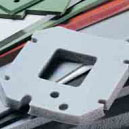Material Differences between Foam Rubber and Sponge Rubber
- 11 July 2017
- Posted by: Madhuraka
- Category: Article
 A foam rubber product shares many material properties with a comparable sponge rubber item, yet they’re not the same. In fabrication terms, a foam uses a blowing or “foaming” agent to inject a polymer melt with gas-filled bubbles. On the other hand, the tiny interlinking chambers in sponge rubber are produced chemically by mixing sodium bicarbonate with an elastomer. Those are major manufacturing differences, the kind of processing routes that require further study.
A foam rubber product shares many material properties with a comparable sponge rubber item, yet they’re not the same. In fabrication terms, a foam uses a blowing or “foaming” agent to inject a polymer melt with gas-filled bubbles. On the other hand, the tiny interlinking chambers in sponge rubber are produced chemically by mixing sodium bicarbonate with an elastomer. Those are major manufacturing differences, the kind of processing routes that require further study.
A Guide to the Manufacturing Differences
Foam rubber production is all about blowing agents. Melted polymer matrices are injected with large volumes of air or some other passive gas. During this sequence, the endothermic reaction and the gaseous injection mechanism locks the bubbles. The end product creates large, structurally rigid cells that perform well as sound and physical impact dampeners. Conversely, the sponge rubber process creates an even finer but denser material structure. Ideal for cushioning purposes, a chemical agitator imbues open or closed cell rubber sponges with a porous build during the moulding stage. Traditionally, sodium bicarbonate is used as the agitator, a chemical that possesses active fluid properties. Incidentally, this is an open cell material variant. Closed cell sponge rubber uses a chemical decomposition process to form sealed bubbles. Nitrogen occupies those squishy balloon cells, so cushioning strength is augmented.
Contrasting Application Examples
An open cell sponge is exactly what it seems: it’s a product that soaks up and traps liquids. Used in kitchens and tough cleanup situations, the openly interlinked chambers absorb liquids, dampen hard impacts, and generally act as a good padding solution. The closed cell variant functions as a gap filler, a noise and vibration attenuator, and even as a seat cushion. Then there are closed and open cell foam rubber products, items that deliver a reinforced structural profile, a rubber material backbone that’s endothermically strengthened during the plastic resin production phase. Foam rubber products include superior noise dampening panels, weatherizing products, and high-performing thermal insulation foams.
Unfortunately, at least for the average consumer, the foam rubber and sponge rubber labels are used interchangeably. Expect to see foam polymers in weatherproofing applications due to a high R-Value feature (Ability to resist heat loss). Meanwhile, denser sponge polymers suit hard impact scenarios. A roll of sponge rubber, for example, performs as an ideal kinetic energy absorber, a soft but durable rubber that’s fitted to automobile doors and other high-impact areas. Finally, a closed cell roll of foam rubber tape installs perfectly as a weather seal or a noise canceller.

